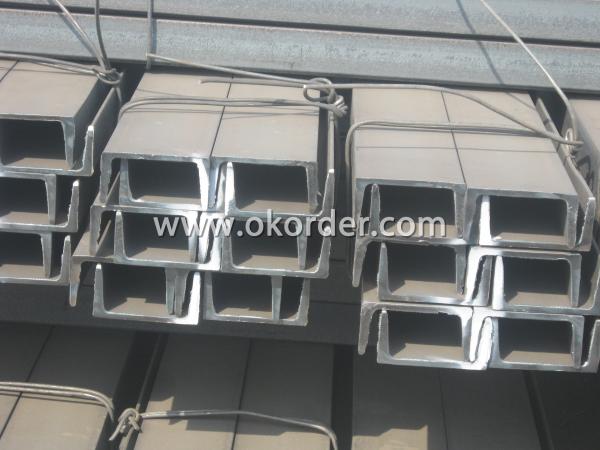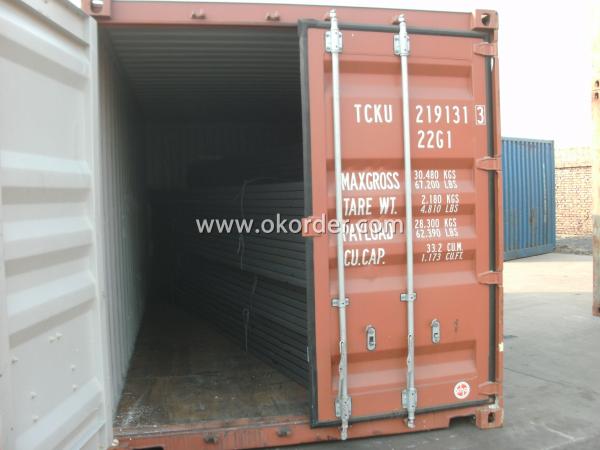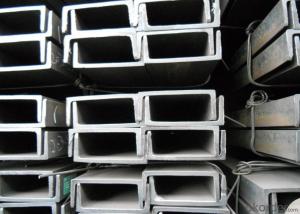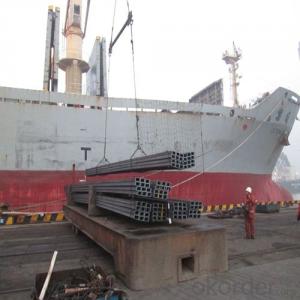JIS U CHANNEL STEEL
- Loading Port:
- Xingang Port
- Payment Terms:
- TT or LC
- Min Order Qty:
- 25MT m.t.
- Supply Capability:
- 80000TON/Year m.t./month
OKorder Service Pledge
OKorder Financial Service
You Might Also Like
Specifications of JIS U Channel Steel:
1. We are definitely speciallizing in manufacturing and supplying channel steel as per japanese standard, which is characterised with high mechanical strength and competitive prices.
Original Place | Tangshan, China | Brand Name | UINDA |
Standard | JIS G3192 : 1990 | ||
Material Grade | SS490 | ||
Sizes | 50mm to 200mm | ||
Sales Volume/Year | 3000MT | ||
Destination Area | Middle East, Africa, Southeast Asia | ||
2. The sections in details are as followings in the table-1
JIS U CHANNEL | Standard | Sectional | Dimension |
| Mass: |
| (mm) | (mm) | (mm) | (mm) |
|
50x25 | 50 | 25 | 3.0 | 6.00 | 2.37 |
75X40 | 75 | 40 | 3.8 | 7.00 | 5.30 |
75X40 | 75 | 40 | 4.0 | 7.00 | 5.60 |
75X40 | 75 | 40 | 4.5 | 7.00 | 5.85 |
75X40 | 75 | 40 | 5.0 | 7.00 | 6.92 |
|
|
|
|
|
|
100X50 | 100 | 50 | 3.8 | 6.00 | 7.30 |
100X50 | 100 | 50 | 4.2 | 6.00 | 8.03 |
100X50 | 100 | 50 | 4.5 | 7.50 | 8.97 |
100X50 | 100 | 50 | 5.0 | 7.50 | 9.36 |
|
|
|
|
|
|
125X65 | 125 | 65 | 5.2 | 6.80 | 11.66 |
125X65 | 125 | 65 | 5.3 | 6.80 | 12.17 |
125X65 | 125 | 65 | 5.5 | 8.00 | 12.91 |
125X65 | 125 | 65 | 6.0 | 8.00 | 13.40 |
|
|
|
|
|
|
150x75 | 150 | 75 | 5.5 | 7.30 | 14.66 |
150x75 | 150 | 75 | 5.7 | 10.00 | 16.71 |
150x75 | 150 | 75 | 6.0 | 10.00 | 17.90 |
150x75 | 150 | 75 | 6.5 | 10.00 | 18.60 |
150x75 | 150 | 75 | 6.5 | 10.00 | 24.00 |
|
|
|
|
|
|
200X80 | 200 | 80 | 7.5 | 11.00 | 24.60 |
Table-1
3. The mechanical property of JIS U Channel Steel in the table-2:
Grade | Yield Strength,N/mm² | Extension Strength N/mm² | |||
Thickness of Steel,mm | |||||
≦16 | >16-≦40 | >40-≦100 | >100 | ||
SS490 | ≧285 | ≧275 | ≧255 | ≧245 | 490-610 |
Table-2
4. The chemical composition of JIS U Channel Steel as per SS490 in the table-3
Grade | Element(%) | |||
C | Mn | P | S | |
SS490 | - | - | ≦0.050 | ≦0.050 |
Table-3
Usage of JIS U Channel Steel:
1.The JIS U Channel Steel can be devided into two kinds, namely common channel steel and light channel steel. The sizes of hot rolled common channel steel range from 5# to 40#. Meanwhile, the channel steel can be divided into cold forming sectional equal channel steel, cold forming sectional unequal channel steel, cold forming inner edge channel steel and outer edge channel steel.
2.The JIS u channel steel is usually used for arch-itechtural structure, and they could be welded in order to support or hang a vari-ety of facilities. They are also usually used in combination with I beam. The channel steel with sizes under 14# is usually applied to construction engineering, as purline, while the channel steel with sizes above 16# is more likely to be used in building vehicle chassis structure and mechanical structure. Furthermore, the channel steel in sizes above 30# are target at building bridge structure, as tension bar.
3.In a word, the channel steel must possess perfect welding property, riveting property and mechanical property and so on.
Package & Delivery of JIS U Channel Steel:
1.The JIS u channel steel will be packed in bundle with steel wire at each end of every bundle and color marking in order to help the customer to recognize his goods more easily at sight.
2. And the channel steel could be loaded into 20ft or 40ft container, or by bulk cargo.If the weight of each bundle reaches more than 3.5 mt, the loading by break bulk cargo should be choosed.When the weight of each bundle reaches less than 3mt, the loading by container should be choosed.
3.As for the transportaion from mill to loading port, the truck will be usually used. And the maximum quantity for each truck is 40mt.
4.All in all, we could do in accordance with customer's request.


Production Flow of JIS U Channel Steel:
1.The steel billet shall be heated in the high temperature furnace.
2. The heated steel billet shall be rolled five to nine times with the aim of shaping the general figure of steel u channel.
3. The rolled steel u channel should be put onto the cooling bed to make the temperature low.
4. The steel u channel should be straighted on the straightener.
5. The straighted steel u channel will be cut into meters by saw, as per customer's requirements.
6. At the last part of production, the channel steel must be tested in order to confirm that the finished products are completely free from crack, pore, slag, scab or fold on the surface.
- Q:120*53*5.5 what's the weight of channel steel?
- Should be the standard channel 12.5X53X5.5D weight is 12.318 kg per meter.
- Q:What are the considerations for selecting steel channel sizes?
- When selecting steel channel sizes, there are several considerations that need to be taken into account. These include the load-bearing capacity required for the intended application, the span or distance between supports, the material and weight of the items being supported, and the structural stability needed. Additionally, factors like cost, availability, and compatibility with other building materials may also influence the selection process. Ultimately, the goal is to choose a steel channel size that can effectively support the intended load while ensuring structural integrity and meeting the project's requirements.
- Q:What are the common design codes and standards for steel channels?
- Steel channels must adhere to various design codes and standards to guarantee their structural integrity and safety. The most widely recognized codes and standards for steel channel design include: 1. The AISC (American Institute of Steel Construction) Steel Construction Manual provides specifications for the design, fabrication, and erection of structural steel for buildings. It offers guidelines for steel channel design, covering dimensions, loading conditions, and connection requirements. 2. The ASCE (American Society of Civil Engineers) publishes standards and guidelines for civil engineering structures, including steel channels. Their publication ASCE 7-16 Minimum Design Loads and Associated Criteria for Buildings and Other Structures specifies the loads and load combinations that steel channels should withstand. 3. The IBC (International Building Code) is a comprehensive set of building regulations adopted globally. It includes provisions for the design of steel channels and other structural elements, emphasizing safety, load resistance, and structural stability. 4. The EN (European Committee for Standardization) standards define specifications for various steel products, including channels. EN 10025-2 specifically covers hot-rolled structural steel channels, outlining their mechanical properties, dimensions, and tolerances. 5. The BSI (British Standards Institution) publishes standards for steel channels under the BS EN 10365 series. These standards address dimensions, tolerances, and technical requirements for hot-rolled steel channels used in construction. Designers, engineers, and manufacturers must comply with these codes and standards to ensure proper design, fabrication, and safe usage of steel channels in diverse structural applications. Adhering to these guidelines promotes consistency, quality, and structural integrity within the construction industry.
- Q:How are steel channels transported and stored?
- Steel channels are typically transported using trucks or trains, with careful consideration given to weight distribution and secure packaging. Once at the storage facility, they are usually stored in racks or on shelves, taking into account their size and weight to ensure safe and efficient stacking.
- Q:Can steel channels be used for walkway supports?
- Yes, steel channels can be used for walkway supports. Steel channels, also known as C-channels, are commonly used in construction for their strength and durability. They provide a stable and reliable support structure for walkways, ensuring the safety of individuals walking on them. Steel channels can be easily installed and can withstand heavy loads and constant foot traffic, making them an ideal choice for walkway supports in various settings such as industrial plants, bridges, and outdoor walkways.
- Q:What is the difference between steel tubes such as channel steel and square tube?
- See how you used, used in what place, general use of channel more points, two channel to live, and then welding, square tube convenient point, but the strength is not good, but time and effort
- Q:Can steel channels be used for access platforms?
- Yes, steel channels can be used for access platforms. Steel channels are commonly used in construction and industrial applications due to their strength and durability. They can provide a sturdy framework for access platforms, ensuring safe and reliable access to elevated areas.
- Q:Can steel channels be used for scaffoldings?
- Yes, steel channels can be used for scaffoldings. Steel channels provide strength and durability, making them suitable for supporting the weight of workers and materials on scaffolds. They can be easily assembled and provide a stable platform for construction and maintenance work at various heights.
- Q:How do steel channels perform in high-load applications?
- Steel channels perform exceptionally well in high-load applications due to their high strength and load-bearing capabilities. The design of steel channels allows for efficient distribution of weight, making them ideal for supporting heavy loads and withstanding significant stresses. The structural integrity of steel channels ensures that they can handle the demands of high-load applications without compromising safety or performance. Steel channels are commonly used in construction, automotive, and industrial sectors where there is a need to support heavy equipment, structures, or machinery. Their robustness and durability make them reliable and long-lasting, even under extreme conditions. Additionally, steel channels have excellent resistance to bending, twisting, and warping, making them suitable for withstanding dynamic loads and vibrations. Another advantage of steel channels in high-load applications is their versatility. They come in various sizes, shapes, and thicknesses, allowing engineers to select the most suitable channel for a specific application. This flexibility in design ensures an optimal fit for different load requirements, giving engineers the ability to optimize the load-bearing capacity while minimizing weight and material costs. Furthermore, steel channels have good corrosion resistance, especially when coated with protective treatments or finishes. This enables them to withstand harsh environmental conditions and maintain their performance over time. Additionally, steel channels can be easily welded, bolted, or fastened together, providing flexibility in construction and allowing for easy customization or modification as needed. In summary, steel channels are highly reliable and efficient in high-load applications. Their strong and durable nature, along with their versatility and resistance to bending and corrosion, make them an excellent choice for supporting heavy loads in various industries.
- Q:What are the common design considerations for steel channels?
- When designing steel channels, there are several common considerations that need to be taken into account. These considerations include the following: 1. Load capacity: One of the primary design considerations for steel channels is their load-bearing capacity. The channel must be able to support the applied loads without experiencing excessive deflection or failure. This involves calculating the maximum expected loads and selecting a channel size and material that can safely carry these loads. 2. Material selection: Steel channels are available in various materials, including carbon steel and stainless steel. The material selection depends on factors such as the required strength, corrosion resistance, and cost. Different steel grades have different mechanical properties, and the appropriate material must be chosen based on the specific application. 3. Structural stability: Steel channels must possess adequate structural stability to resist buckling or collapsing under the applied loads. The design should consider the channel's length, support conditions, and the potential for lateral torsional buckling. By analyzing these factors, appropriate design measures can be taken to ensure the stability of the channel. 4. Connection design: Another important consideration is the design of the connections between steel channels and other structural elements. The connections must be designed to transfer loads effectively and securely, ensuring the overall structural integrity of the system. Factors such as joint type, fastener selection, and weld design need to be considered for proper connection design. 5. Fire resistance: In certain applications, fire resistance is a critical consideration for steel channels. The design should account for the required fire rating by incorporating appropriate fire protection measures, such as intumescent coatings or fire-resistant insulation materials. 6. Manufacturing constraints: The design must also take into consideration the manufacturing constraints involved in producing steel channels. This includes considerations such as standard sizes, manufacturing tolerances, and availability of specific profiles. By working within these constraints, the design can be optimized for ease of production and cost-effectiveness. In conclusion, when designing steel channels, it is crucial to consider factors such as load capacity, material selection, structural stability, connection design, fire resistance, and manufacturing constraints. By addressing these considerations, engineers can develop safe and efficient designs for steel channels that meet the specific requirements of the intended application.
1. Manufacturer Overview |
|
|---|---|
| Location | Hebei, China |
| Year Established | 1993 |
| Annual Output Value | Above US$100 Million |
| Main Markets | South Asia Middle East; Southeast Aisa; south Korea |
| Company Certifications | ISO 9001:2000 |
2. Manufacturer Certificates |
|
|---|---|
| a) Certification Name | |
| Range | |
| Reference | |
| Validity Period | |
3. Manufacturer Capability |
|
|---|---|
| a)Trade Capacity | |
| Nearest Port | Tianjin; |
| Export Percentage | 1% - 10% |
| No.of Employees in Trade Department | 11-20 People |
| Language Spoken: | English; Chinese |
| b)Factory Information | |
| Factory Size: | Above 20,000 square meters |
| No. of Production Lines | 1 |
| Contract Manufacturing | OEM service offered |
| Product Price Range | average |
Send your message to us
JIS U CHANNEL STEEL
- Loading Port:
- Xingang Port
- Payment Terms:
- TT or LC
- Min Order Qty:
- 25MT m.t.
- Supply Capability:
- 80000TON/Year m.t./month
OKorder Service Pledge
OKorder Financial Service
Similar products
New products
Hot products
Hot Searches
Related keywords




























